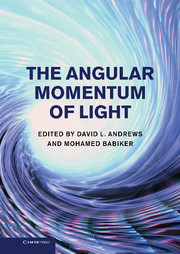Book contents
- Frontmatter
- Contents
- List of contributors
- Preface
- 1 Light beams carrying orbital angular momentum
- 2 Vortex transformations and vortex dynamics in optical fields
- 3 Vector beams in free space
- 4 Optical beams with orbital angular momentum in nonlinear media
- 5 Ray optics, wave optics and quantum mechanics
- 6 Quantum formulation of angle and orbital angular momentum
- 7 Dynamical rotational frequency shift
- 8 Spin-orbit interactions of light in isotropic media
- 9 Quantum electrodynamics, angular momentum and chirality
- 10 Trapping of charged particles by Bessel beams
- 11 Theory of atoms in twisted light
- 12 An experimentalist's introduction to orbital angular momentum for quantum optics
- 13 Measurement of light's orbital angular momentum
- 14 Efficient generation of optical twisters using helico-conical beams
- 15 Self-similar modes of coherent diffusion with orbital angular momentum
- 16 Quantum entanglement of orbital angular momentum
- Index
- References
1 - Light beams carrying orbital angular momentum
Published online by Cambridge University Press: 05 December 2012
- Frontmatter
- Contents
- List of contributors
- Preface
- 1 Light beams carrying orbital angular momentum
- 2 Vortex transformations and vortex dynamics in optical fields
- 3 Vector beams in free space
- 4 Optical beams with orbital angular momentum in nonlinear media
- 5 Ray optics, wave optics and quantum mechanics
- 6 Quantum formulation of angle and orbital angular momentum
- 7 Dynamical rotational frequency shift
- 8 Spin-orbit interactions of light in isotropic media
- 9 Quantum electrodynamics, angular momentum and chirality
- 10 Trapping of charged particles by Bessel beams
- 11 Theory of atoms in twisted light
- 12 An experimentalist's introduction to orbital angular momentum for quantum optics
- 13 Measurement of light's orbital angular momentum
- 14 Efficient generation of optical twisters using helico-conical beams
- 15 Self-similar modes of coherent diffusion with orbital angular momentum
- 16 Quantum entanglement of orbital angular momentum
- Index
- References
Summary
For optical fields the notion of a total angular momentum has long been known. The concept of a light beam carrying orbital angular momentum, however, was unfamiliar until it was discovered that Laguerre-Gaussian beams, within the paraxial approximation, carry a well-defined orbital angular momentum [1, 2]. This discovery started the modern interest in orbital angular momentum of light. In this chapter we discuss the theoretical framework of orbital angular momentum of light in terms of fields and light beams and how to generate these. The material in this chapter is based in parts on the PhD thesis of Götte [3].
Introduction
A quantitative treatment of the mechanical effects of light became possible only after light had been integrated into Maxwell's dynamical theory of electromagnetic waves. With this theory Poynting [4] derived a continuity equation for the energy in the electromagnetic field. After Heaviside [5, 6] introduced the vectorial notation for the Maxwell equations this continuity equation could be written in its modern form using the Poynting vector. Interestingly, the linear momentum density in the electromagnetic field is also given by the Poynting vector apart from constant factors depending on the chosen system of units. Poynting [7] also derived an expression for the angular momentum of circularly polarised light by means of a mechanical analogue in the form of a rotating shaft. Later, Poynting's expression was verified by measuring the torque on a quarter wave-plate due to circularly polarised light [8].
- Type
- Chapter
- Information
- The Angular Momentum of Light , pp. 1 - 30Publisher: Cambridge University PressPrint publication year: 2012
References
- 3
- Cited by

